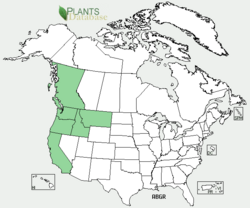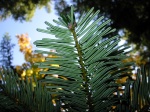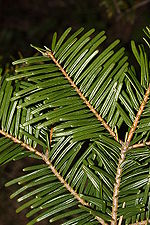Grand fir
| Grand fir |
|---|

|
| Scientific Classification |
| Binomial Name |
|
Abies grandis |
| Grand Fir North America habitats |
The Grand Fir is a species of conifer trees that is native to the Northwest USA, and perhaps best known for its use as Christmas trees. It is also occasionally called a lowland white fir, balsam fir, or yellow fir. It is an important historical tree used by settlers coming to the Pacific Northwest to control their wagons' descent at steep locations. Some of those trees in Oregon are still there, even after around one hundred fifty years.[1]
Anatomy
The Grand Fir is a very large tree, often growing up to seventy-five meters tall. The bark is a grayish color, turning brown as it ages. New branches grown are a darkish green, with slight ridges.[2] It is an evergreen, staying a beautiful green in the winter. In the summer, it can be a medium, regular green to yellowish green. [3]The branches spread and gracefully flop over. The twigs are opposite, becoming light brown. The needle tips are notched, which is a key part in identifying the Grand Fir. It’s needles are arranged fairly like a comb. [4] These are either purple, green, or brown, and are circular. The buds can be small or fairly large. The leaves can be anywhere from two to six centimeters long. The leaves located at the center of the branch may be longer than at the ends, or the long and short leaves can be mixed up. Higher in the tree, the leaves curve upward.
The tallest Grand Fir was eighty-one point four meters tall. The oldest one (1977) had 472 rings, and one hundred sixty-three of those rings were in the first seven point six centimeters of the sample taken. The tree doesn’t smell very pleasant. It’s pollen cones, when ready to be pollinated, can be anywhere from bluish reddish, to purple, to even orange or yellow. The seed cones are cylinder shaped, and are usually either green, blue, purple, or gray. The seeds are tan, and can be from six by three to eight by four. [5] The fruits produced by it have bright green cones, around three to four inches long, and are cylinder shaped. [6]
Reproduction
The Grand Fir reproduces by seed. It is the only variety of its kind. [7] It flowers at any time from the middle of April to the middle of June. The cones get ripe by August, and the seeds that are produced by the tree are dispersed anywhere from near the end of August to the beginning of September. The seeds can live up to or over five years; to be germinated they need a cold, wet period of about fifteen to thirty days. They grow best after those conditions occur and become buried around a half of a centimeter deep and covered with a little layer of mulch; it germinates best on any mineral soil. If stored, it’s best to store the seeds without moisture in airtight containers at around 23 degrees Fahrenheit.
If being planted, it’s best to space the Grand Fir around twenty to thirty feet apart from any other tree, giving it a lot of growth room. After planting, it’s best in cooler weather, and a medium amount of wooded shade. If it is grown in the sun, it will grow less than its best compared to trees that dislike shade and grow quicker. The Grand Fir is mature at anywhere from twenty to thirty years. It’s very common to find them around two hundred fifty years old; there have been claims of discovering Grand Firs over three hundred years old, but no proof. At it’s mature age it grows the fastest in clearings. [8]
Ecology
Grand Firs grow naturally anywhere from British Columbia to Montana, Idaho, Washington, Oregon, even California, mostly in forests with other conifers. [9] It likes to grow in soil that is moist, deep, well-drained, and acidic. Considering other Abies species are not Abies grandis is surprisingly shade tolerant; it grows best in the sun with part shade. It is a good tree in parks, and very easy to be a specimen. Considering it is a large tree, it is too big for a lot of different uses, and is not easy to find for businesses. When grown in the eastern U.S. it grows poorly. [10] It likes to grow in dry climates, places that have less than around fifty-nine inches of precipitation yearly. It will grow from sea level to five thousand feet above sea level. In some habitats it is the most common species of tree, and it’s ability to live for a long time helps its dominance. [11]
Lifespan
The long living Grand Fir has many factors that influence why it is able to live so long. It has a moderate resistance to fire when compared to species of the western pine type. It’s habitat also helps determine how fire resistant it is, like if it is growing from the bottom of a creek, the Grand Fir will be easily destroyed by the fire. If it is used to living on a dry hill it is much better at being resistant to fire, since it needs longer roots with much thicker bark when living on a hill. During the coldest weather the Grand Fir’s needles resist the temperature wonderfully, and it’s leaves can withstand negative sixty-five degrees Fahrenheit without any problems. Sometimes, if there’s a sudden drop in the temperature it will hurt the needles compared to if it steadily decreases. Snow is a bit of a problem for the Grand Fir, it can get frost cracks, which don’t kill the tree, but contribute to things that do, like fungus. There are insects that are able to damage it badly; examples are the western spruce budworm, the western bark beetle, even an insect called the fir engraver.[12]
Gallery
References
- Abies Grandis Christopher J. Earle. The Gymnosperm Database. last updated 2008.05.01. visited 5/17/09.
- Abies Grandis Mark H. Brand. http://www.hort.uconn.edu/. visited 5/17/09.
- Grand fir, Abies Grandis Yongjiang Zhang. http://depts.washington.edu. April 11, 2003. visited 5/16/09.
- USDA, NRCS. 2009. The PLANTS Database (http://plants.usda.gov, 17 May 2009). National Plant Data Center, Baton Rouge, LA 70874-4490 USA.
- Grand fir Marvin W. Foiles, Russel T. Graham, and David F. Olson, Jr. USDA forest service. visited 5/17/09.
- Dave Powell, USDA Forest Service, Bugwood.org






